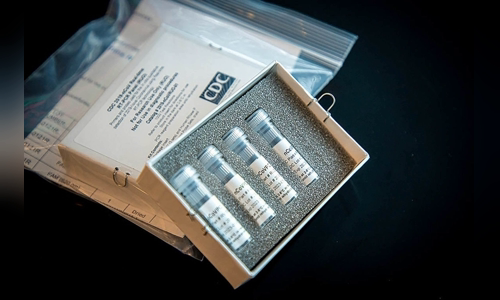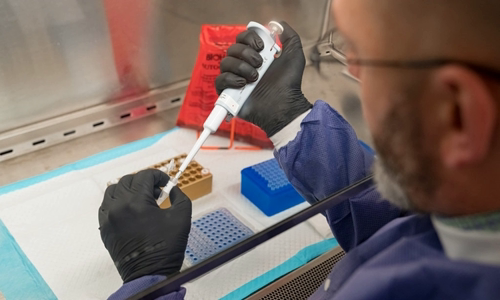nCoV has "taken advantage" of the gap in the US public health shield to silently spread, which is a test-related issue.
The US recorded 103 people infected with nCoV, 6 died. Dozens of patients in some states may have contracted the virus in the community (nCoV infection, although not in an epidemic area, no contact with people who have been abroad or who have been confirmed to be infected with the virus). The number of infections is increasing not only because the virus is spreading but also because federal officials have more people tested.

Test kits were once distributed by CDC Photo: CDC
An increasing number of people found to be positive for nCoV are raising questions about the authorities' initial treatment: Why not get more people tested earlier? How many people are carriers? Does the lack of testing equipment have created a loophole for nCoV to have the opportunity to spread in the United States without restraint?
"There is clearly a problem with the test deployment," said Thomas Frieden, former CDC director. "A lot of doctors, patients and health departments are disappointed."
In early February, the Centers for Disease Control and Prevention (CDC) introduced a three-step testing method and delivered test kits to state and local health laboratories. But some kits components are faulty and give incorrect results.
The CDC promised to provide replacement goods, but a few weeks later, the promise was not fulfilled. The agency did not explain it clearly, but only said it had errors in production. Therefore, testing is only done at an agency laboratory in Atlanta.
The CDC eventually introduced a two-step test method and allowed several laboratories, where standardized kits were available, to continue testing. But many other rooms are still unable to diagnose patients themselves.
Each time a sample is sent to the CDC, officials have to wait a few days to receive the result and not everyone who is suspected of being tested will be tested. They have very strict standards: patients have to come to China recently or contact with people who have confirmed infection.
Doctors across the country have complained about this issue. CDC says it is capable of testing about 400 samples per day. "The criteria are so strict that many people are not tested," said Lauren M. Sauer, from Johns Hopkins Medical University.
By the end of last week, when community-based nCoV infections began to appear in California and Washington state, CDC expanded the criteria for patients eligible for testing, including those returning from new outbreaks such as Korea and Italy, for patients with severe symptoms of unexplained hospitalization.
"We are really disappointed, because public health laboratories should always be in a state of being" in position! Ready! Action! "And we" Get into position! Ready! Wait! "Said Scott Becker, executive director of the Association of Public Health Laboratories.
Last weekend, the US Food and Drug Administration (FDA) authorized state and local laboratories to do the tests themselves. If the labs have developed the test themselves, they can use it to make a diagnosis instead of relying on the CDC version. This move has significantly increased the number of people tested across the country.
However, by that time, the agency had tested less than 500 Americans suspected of being infected. Meanwhile, other countries have tested tens of thousands of people. China may have tested millions of people. "Why can Korea do 10,000 tests a day we can't," says Ralph Baric, at the University of North Carolina.

A researcher at the New York State Department of Health Virus Laboratory prepares a test sample, the state uses its own self-developed testing device. Photo: S? Y t? bang New York
"We know that the virus can spread during incubation and it has spread so strongly in China, why don't the US perform tens of thousands of tests?", He said.
In fact, shortly after the outbreak began in China, CDC developed a test. "Normally, CDC is the provider of testing methods for the world," Frieden said.
But in this case, German researchers were a step ahead, developing their own test method, which was accepted by WHO and quickly distributed worldwide.
After the CDC version was found to have bugs, the agency continued to seek a fix, even though the German kits were widely used. "They have chosen a very American approach. They think 'we are American, are the major public health agency of the United States and we will not have to follow the other side," Michael Mina, epidemiologist at Harvard University, says.
The new kits were distributed over the weekend and will continue to be available in the near future, US Secretary of Health and Humanity Alex M. Azar II said Tuesday.
But there are still many people who have not been tested. "It looks like we won't be tested," said Jennifer Knight, who returned from Milan with a group of friends. Some members of the group fell ill in Milan shortly after returning to the US. Knight has a migraine and sore throat, her boyfriend also has a fever and cough. Staff at an emergency clinic told her over the phone that they did not have the nCoV test. So is a Brooklyn hospital.
"Whenever we ask for a test, we are 'thrown out the door," she said. She and her boyfriend are currently quarantining themselves at home.
On Rhode Island, Onésimo T. Almeida, a professor at Brown University, had been coughing, sneezing and fever for almost a week after attending a seminar in Portugal. A friend who also attended the event was positive for nCoV. But when Almeida called the Rhode Island Health Department and asked for a test, he was told he didn't fit the criteria.
On March 2, the health department called Almeida and asked him to drive to the hospital, telling the medical staff that he would come into his car in the afternoon and get tested at the parking lot. A doctor removed fluid from the mouth, nose and throat through the car window. Almeida feels like she's having an alcohol test instead of a viral test.
The number of suspected people getting tested may increase in the next few weeks. But that may be too late because asymptomatic people spread nCoV in the community.
"nCoV has quietly crept into the US community and it is no longer silently there," said Michael Osterholm, an epidemiologist at the University of Minnesota.



 KenroyWalters
KenroyWalters







